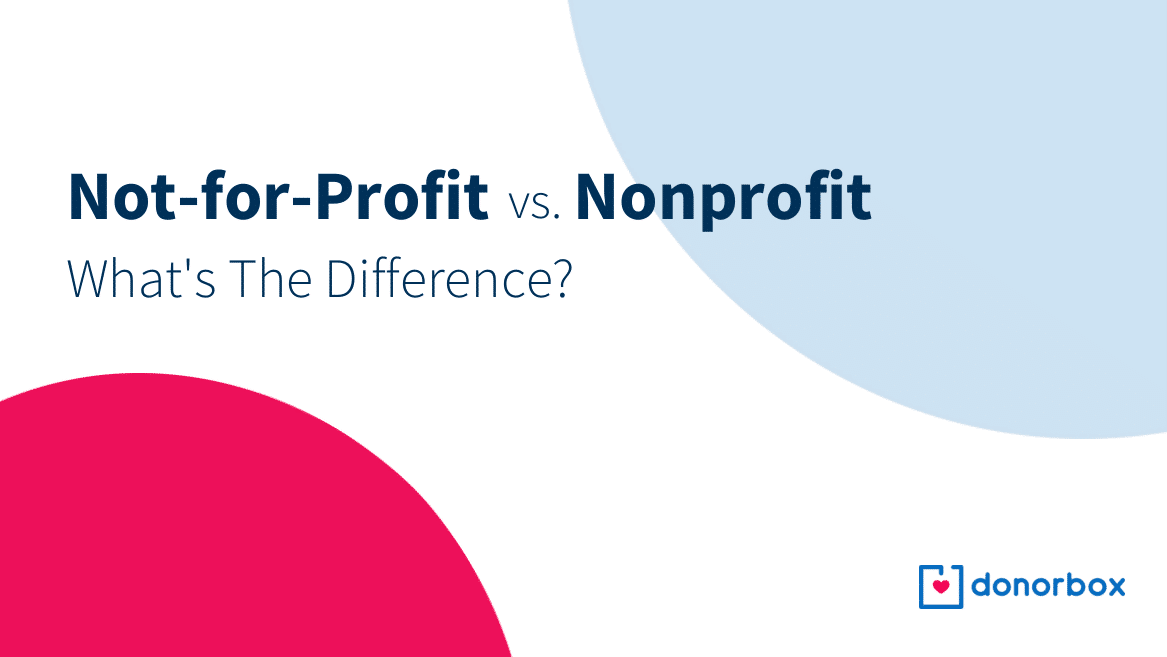Not-for-profit vs. nonprofit. Two words for the same type of organization, right? Well, not exactly.
Although this may come as a surprise to some (and it’s easy to see why), not-for-profit and nonprofit organizations are distinctly different. While neither exists to make money, they have contrasting missions and functions as well as business structures and tax implications.
In this article, we’ll share the difference and similarities between nonprofit and not-for-profit organizations as well as discuss how they compare to for-profit companies.
What is a Nonprofit Organization?
By definition, nonprofits do not aim to turn a profit – it’s right there in the name. Instead, they serve the public good. While they do operate to earn revenue, nonprofits raise funds via donations, grants, and endowments to benefit an external cause.
Nonprofits include charities and foundations, as well as educational organizations, religious organizations, and hospitals. They each have a specific mission, from sheltering the homeless to caring for animals to finding a cure for cancer. But their overall goal is the same across the board: help those in need and make the world a better place.
Nonprofits are tax-exempt organizations operating under the Internal Revenue Service (IRS) 501(c)3 tax code in the United States, meaning they do not pay any taxes on money received through fundraising. But they must make all financial and operating information public so that potential supporters can see how their gifts will be used. In addition, an individual or business that gives to a nonprofit organization can deduct their donation from their tax return.
Examples of well-known nonprofit organizations include Habitat for Humanity, Make-a-Wish Foundation, Nomi Network, Healthcare for the Homeless, and so many more.

What is a Not-for-Profit Organization?
Like nonprofits, not-for-profits do not earn money for any owners. Not-for-profits, however, only aim to benefit their members – every dollar raised or earned goes directly into running the organization. They do not have to operate for the public good.
Not-for-profits can also apply for tax-exempt status with the United States Internal Revenue Service (IRS) and may receive exemptions from property taxes and sales taxes. There’s a big list of 501(c) tax codes, all of which are tax-exempt. But not all can accept tax-deductible donations from individuals and businesses!
There can be different types of not-for-profits: social organizations, community organizations, and clubs. Social organizations can help improve the lives of the homeless or support veterans and their families. Community organizations mainly focus on causes within the community, such as cleaning the roads, renovating parks, planting more trees, etc. Clubs usually raise funds to improve their own activities.
An example of a not-for-profit organization would be a sports club, such as a travel baseball team raising funds for new uniforms or attending a weekend tournament. 501(c)(7) social clubs are also not-for-profits.
Boys & Girls Clubs of St. Lucie County (shown below) and college fraternities and sororities are examples of not-for-profit organizations.

Not-for-Profit vs. Nonprofit: The Key Differences
1. Missions and objectives
Not-for-profits and nonprofits may both only earn funds to support their missions, but these missions, as well as organizational objectives, are often very different.
Nonprofits aim to benefit the public good through a mission that serves others, such as feeding the hungry, building schools, or providing clean water. Instead of raising funds to make money, they seek to earn enough revenue to fulfill and grow this mission.
Not-for-profits are not required to serve the public good. Instead, they operate to fulfill their own objectives and benefit the members of their organization.
2. Management and organizational structure
Nonprofits are managed and structured like for-profit businesses. They technically still try to earn a profit, but only so that they can turn around and use this money to support the beneficiaries of their mission. In addition, nonprofits may have paid employees and/or volunteers running day-to-day operations.
Not-for-profits do not have a goal of earning any sort of revenue. They only strive to earn enough funds through business activities or donations to support their objectives, whether that be purchasing a team bus or hosting a social event. Also, unlike many nonprofits, not-for-profits are solely run by volunteers.
3. Legal entities
Nonprofit organizations can have a separate legal entity through which to conduct business.
Not-for-profit organizations, however, cannot have a separate legal entity.
4. Tax implications
Although both a not-for-profit and nonprofit organization can apply for tax-exempt status with the IRS, they operate under different codes. All nonprofits receive a 501(c)3 status upon approval, but not-for-profit organizations fall under a variety of other 501(c) tax codes.
In addition, all donations made to a registered 501(c)3 organization are considered tax-deductible. So, any individual or business that makes a gift may deduct it from their income tax.
But most contributions made to not-for-profit organizations cannot be deducted, with a few exceptions, such as some volunteer fire departments.
What Are The Similarities Between Not-for-Profit and Nonprofit Organizations?
1. Profits are not the goal
We’ve already mentioned this many times – and we’re sure you already knew this – but it is worth saying again: nonprofit organizations and not-for-profit organizations do NOT exist to earn profits for owners.
2. Ability to accept donations
Both nonprofits and not-for-profit organizations can accept contributions from individuals and businesses – in fact, that’s the primary way both types of organizations are able to capture the funds they need to operate.
As stated above, however, not all not-for-profit organizations are eligible to receive tax-deductible donations. But, again, there are exceptions!
The Boys & Girls Clubs of St. Lucie County, a not-for-profit organization, uses the below donation page by Donorbox to accept donations for their club. Their page clearly mentions the organization’s status (right below the donation form), however, they refrain from mentioning if donations are tax-deductible.

This is quite in contrast to the tax-deductibility of nonprofit donations. For example, McIntyre House, a 501(c)(3) nonprofit, used Donorbox Crowdfunding to raise funds for its beneficiaries. They’ve mentioned on this donation page (under the social sharing buttons) that all donations to their nonprofit organization are tax-deductible.

3. The tax-exempt status
Nonprofit organizations and not-for-profit organizations may both apply to receive tax-exemption status from the United States IRS so that they don’t have to pay various types of taxes.
The IRS lists the requirements for applying for tax-exemption status. It is mandatory for both types of organizations to be compliant with these rules.
Nonprofit vs. Not-for-Profit vs. for-Profit
There are several differences (even similarities) between for-profits and nonprofits and not-for-profits. The main difference, as the names suggest, lies in how they handle profits.
Most business entities operating around the world today are, indeed, for-profit organizations. Unlike nonprofits, for-profit companies seek to make a lot of money, primarily by selling a product or service to a target audience. The business owner hopes to return a profit and make money for him or herself and may also pay shareholders and investors.
On the contrary, nonprofits often run like for-profit businesses, trying to create a revenue stream through fundraising and similar activities. This revenue is then used to fund their mission. Not-for-profits, on the other hand, do not really function with the goal of earning any revenue; their aim remains to benefit their own members and activities through the raised funds.
Nonprofits, like for-profits, can have paid staff. On the other hand, not-for-profits are mainly run by volunteers.
Unlike nonprofits and not-for-profits, for-profit business entities cannot be registered as tax-exempt organizations. They can, however, seek income tax breaks by making tax-deductible contributions to nonprofits – some even match their employees’ charitable donations.
For-profit organizations do not often have many restrictions on the activities they can perform. On the other hand, nonprofits tend to have a lot of restrictions. Not-for-profits have restrictions as well, but fewer than those of nonprofits.
Despite all the differences, for-profits, not-for-profits, and nonprofits do share a similarity. Nonprofits and not-for-profits usually set strategies and long-term/short-term goals, just like for-profits. They also have teams and departments deployed to put these strategies to work and achieve their goals.
Final Thoughts
To recap, nonprofit and not-for-profit organizations are, in fact, very different, although neither aim to earn a profit.
Nonprofits exist to serve the good of the community and only raise funds that will directly impact their mission of helping others. Not-for-profits, on the other hand, raise money to benefit their internal members. And, while both types of organizations can apply for tax-exempt status with the IRS, all 501(c)(3) nonprofits can accept tax-deductible contributions. while only a select few not-for-profits are able to do so.
But the biggest similarity between not-for-profits and nonprofits is that both raise funds for their missions. And Donorbox remains one of the most affordable and simple-to-use online fundraising platforms for both types of organizations! You can get started in minutes and use our features to scale your fundraising and donor management efforts. Learn about these features (Crowdfunding, Peer-to-Peer, Text-to-Give, Events, Memberships, Recurring Donation Forms, Donation Pages, and more!) on our website.
Looking for more information about fundraising, building awareness, and more for your nonprofit or not-for-profit? Check out our other articles on the Donorbox Nonprofit Blog. Subscribe to our newsletter and we’ll ensure that our best resources are delivered to your inbox every month.








